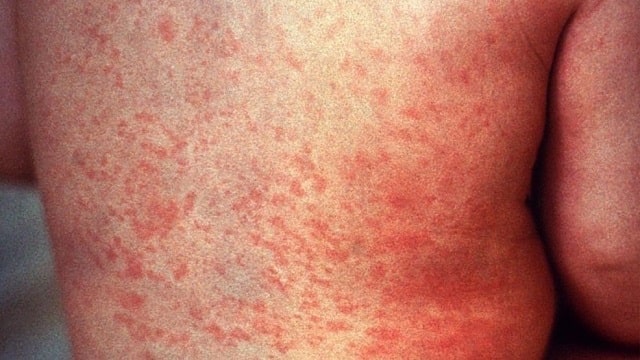What is Measles?
Measles is a highly contagious respiratory infection. It is characterized by a skin rash all over the body and flu-like symptoms. Measles is caused by a virus that can be transmitted through saliva droplets.
Symptoms generally appear about one to two weeks after the body is exposed to the virus.
This disease is most common in children and can be fatal. However, this disease can be prevented by getting vaccinated.
Measles Symptoms
Early symptoms of measles infection usually include a productive cough, runny nose, high fever, and red eyes.
Children may also have Koplik spots (small red spots with blue-white centers) inside the mouth before the rash begins.
The rash will then appear 3–5 days after the initial symptoms begin.
The order of appearance of these spots is from behind the ears, around the head, then to the neck. Eventually, the rash will spread throughout the body.
The following are the symptoms, namely:
- Eyes are red and sensitive to light.
- Resembles cold symptoms such as dry cough, runny nose, and sore throat.
- Weak and tired.
- High fever.
- Aches and pains.
- Not enthusiastic and losing appetite.
- Diarrhea or/and vomiting.
- Small grayish-white patches in the mouth and throat.
Causes of Measles
Measles is caused by the rubeola virus. It is spread through direct contact with an infected person or through airborne droplets.
Measles virus is classified as a member of the genus Morbillivirus in the family Paramyxoviridae. Humans are the only natural host of measles virus.
The virus enters the body through the mouth, nose, or eyes. Once there, it most likely enters the lungs, where it infects immune cells.
These cells move to the lymph nodes, where the virus moves to other cells and then spreads throughout the body, releasing viral particles into the blood.
As blood flows throughout the body, it carries the virus to various organs, including the liver, skin, central nervous system, and spleen.
In the skin, the measles virus causes inflammation of the capillaries. This gives rise to the characteristic measles rash.
It takes six to 21 days for measles symptoms to appear after infection.
The sufferer can transmit the disease for about four days before the rash appears until about four days after the rash appears.
Measles Risk Factors
Generally, this condition more often affects children under the age of five.
However, anyone can be infected with the virus. A person is also more susceptible to measles if they have never had the disease or have not been vaccinated.
Here are some risk factors for measles:
1. Have not received vaccination
You are at higher risk of developing this disease if you have not received the measles vaccine.
2. Traveling abroad
If you travel to a developing country, where this condition is common, you are at higher risk of developing the disease.
3. Vitamin A deficiency
People who do not consume enough vitamin A are also at risk of experiencing severe symptoms and complications.
Measles Diagnosis
The diagnosis of measles is determined based on the clinical picture, namely the signs and symptoms experienced by the patient.
However, in special cases, doctors can perform supporting examinations, such as complete blood tests, antibodies to measles, and liver function.
Examination using reverse transcriptase-polymerase chain reaction (RT-PCR) can also determine the diagnosis with certainty. However, in most cases, this is not necessary.
Measles Treatment
Since it is caused by a virus, there is no specific medical treatment for this condition. The disease can heal on its own.
To relieve the symptoms, here are the treatments that can be done:
- Drink plenty of water to prevent dehydration.
- Get plenty of rest and avoid sunlight while your eyes are still sensitive to light.
- Take fever-reducing medication and pain relievers.
Measles Prevention
Measles is also known as rubeola. There is now a vaccine available to prevent this disease.
The vaccine for this disease is part of the MMR vaccine. The MMR vaccine is a combined vaccine for measles, mumps, and rubella.
MMR vaccination is given twice. The first is given when your little one is 15 months old and the next dose of MMR vaccine is given when they are 5–6 years old or before entering elementary school.
Vaccines have a very important function in preventing measles.
How does the measles vaccine work? When you get the measles vaccine, your immune system makes protective antibodies against a weakened vaccine virus.
That way, if you ever get infected with the virus that causes measles, your immune system can fight off the virus.
Complications of Measles
This disease must be watched out for, even though the number of people suffering from measles complications is not too high.
Complications that can occur due to this disease are:
- Bronchitis.
- Lung infection (pneumonia).
- Inflammation of the ear.
- Brain infection (encephalitis).
- Encephalitis (inflammation of the brain).
- Meningitis (inflammation of the lining of the brain).
- Diarrhea.
- Death.

